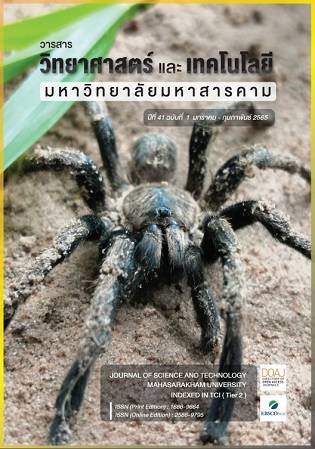Effects of nutritional-promoting program on reducing prevalence of overweight and obesity school-age children: A Case study
Main Article Content
Abstract
Abstract
Childhood obesity epidemic is a threatening health condition to Thai children. Overweight and obese children are at greater risk for health problems, especially non-comunicable diseases. A quasi-experimental study was aimed to investigate effectiveness of a nutrition intervention program for behavioral modification in overweight and obese school-age children. Forty participants (20 each for control and experimental groups) were children aged between 6-12 years old with overweight and obesity (+2SD to >+3SD) who lived with their parents during an implementing period. The experimental group received a nutritional-promoting program, while the control group received standard care for 3 months and 3 months of follow-up. The data were collected using a 24-hour dietary recall questionnaire and anthropometric assessment. The outcome of the program was analyzed by comparing calories consumed between groups by analysis of covariance (ANCOVA) under general estimating equations (GEE) models. Post-intervention results showed that the experimental group consumed less than the control group by 323.33 kcal (95% CI = 215.00 to 421.23, p - value < 0.001). At the end of the program, a proportion of school–age children who managed to control their weight within the normal nutritional status (>-1.5 S.D. to +1.5 S.D.) were 8 cases (40%) and 4 case (20%) in the experimental and control groups, respectively. In conclusion, the nutritional-promoting program for overweight and obesity school-age children in school settings was plausible and should be further implemented for long-term use.
Article Details
References
2. จตุพร จำรองเพ็ง, จีราภรณ์ กรรมบุตร, ณัฐพัชร์ บัวบุญ. (2562). ผลของโปรแกรมควบคุมน้ำหนักต่อพฤติกรรมการบริโภคอาหาร พฤติกรรมการมีกิจกรรมทางกายและน้ำหนักตัวของเด็กวัยเรียนตอนปลายที่มีภาวะน้ำหนักเกิน. วารสารวิจัยทางวิทยาศาสตร์สุขภาพ;13(1), 1-10.
3. ประไพ เดชคํารณ. โรคอ้วนในเด็ก. [Online], 2 สิงหาคม 2559. https://www.chiangmaihealth.go.th/ cmpho_web/document/160817147141801012.pdf.
4. ปุลวิชช์ ทองแตง และจันทร์จิรา สีสว่าง. (2555). ภาวะน้ำหนักเกินในเด็กไทย. รามาธิบดีพยาบาลสาร;18(3): 287-297.
5. รังสรรค์ ตั้งตรงจิต และเบ็ญจลักษณ์ ผลรัตน์. (2550). โรคอ้วนการเปลี่ยนแปลงทางด้านโภชนาการและชีวเคมี. กรุงเทพฯ : เจริญดีมั่นคงการพิมพ์, 1-36.
6. ลัดดา เหมาะสุวรรณ. (2553). โภชนาการในเด็กไทย. สงขลา: ชานเมืองการพิมพ์.
7. สาธิต เมืองสมบูรณ์, ทวีศักดิ์ เตชะเกรียงไกร, พรทิพย์ พสุกมลเศรษฐ์, อาพร แจ่มผล, ปาริสุทธิ์ เฉลิมชัยวัฒน์, ฤทัย เรืองธรรมสิงห์, และคณะ. (2562). ผลของตำรับอาหารไทยมื้อกลางวันที่มีต่อภาวะโภชนาการของเด็กวัยเรียน : กรณีศึกษาโรงเรียนสังกัดสำนักงานเขตพื้นที่การศึกษาประถมศึกษานครนายก. วารสารวิทยาลัยดุสิตธานี; 13(1), 284-301.
8. สุนทรี รัตนชูเอก, พัชราภา ทวีกุล, อรวรรณ เอี่ยมโอภาส, และอุมาพร สุทัศน์วรวุฒิ. (2557). แนวทางเวชปฏิบัติการป้องกันและรักษาโรคอ้วนในเด็ก. กรุงเทพฯ: ชมรมโภชนาการเด็กแห่งประเทศไทย, ราชวิทยาลัยกุมารแพทย์แห่งประเทศไทย.
9. สำนักโภชนาการ กรมอนามัย กระทรวงสาธารณสุข. (2558). คู่มือการจัดการอาหารกลางวันนักเรียน ตามมาตรฐานโภชนาการ สุขาภิบาลอาหารและอาหารปลอดภัย สำหรับโรงเรียนประถมศึกษา. กรุงเทพฯ.
10. สำนักโภชนาการ กรมอนามัย กระทรวงสาธารณสุข. (2561). แนวทางการจัดอาหารกลางวัน “เด็กวัยเรียน”. กรุงเทพฯ.
11. Bareu of Nutrition. Department of Health. (2014). Guidelines for the control and prevention of overweight students.5th ed.Bangkok: Veterans Publishing.
12. Demir D. & Bektas M. (2021). The effect of an obesity prevention program on children's eating behaviors, food addiction, physical activity, and obesity status.Journal of Pediatric Nursing; 61: 355-363
13. Eric AF, Olga AK, Hope T, Justin GT, Liping P, Bettylou S, et al,. (2012). Obesity and severe obesity forecasts through 2030. American Journal of Preventive Medicine. 42(6): 563-570.
14. Janssen L. & LeBlanc A.G. (2010). Review Systematic review of the health benefits of physical activity and fitness in school-aged children and youth. International Journal of Behavioral Nutrition and Physical Activity; 7(40): 1-16.
15. Mo-suwan L, Lebel L, Puetpaiboon A, Junjana C. (1999). School performance and weight status of children and young adolescents in a transitional society in Thailand. International journal of obesity and related metabolic disorders; 23(3): 272-277.
16. Robinson TN, Matheson D, Desai M, Weintraub DL, Banda JA, McClain A. et al,. (2021). A community-based, multi-level, multi-setting, multi-component intervention to reduce weight gain among low socioeconomic status Latinx children with overweight or obesity: The Stanford GOALS randomised controlled trial. The Lancet Diabetes & Endocrinology; 9(6): 336-349.
17. World Health Organization. (2000).Obesity: preventing and managing the global epidemic : report of a WHO consultation. https://apps.who.int/iris/handle/10665/42330.


